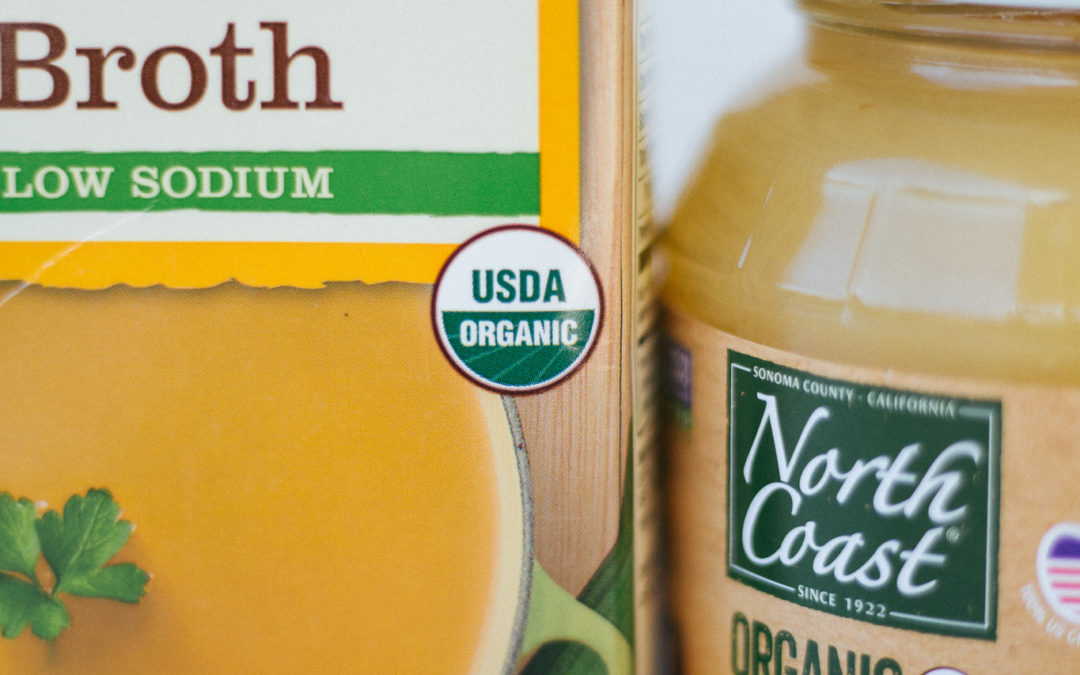In the last 50 years, our food has changed (and been changed) drastically. Between the pesticide use, synthetic fertilizers, and chemicals that are often sprayed onto soil and produce before harvest, conventionally-grown food just isn’t what it used to be.
I’ll be the first to admit that I jumped on the organic-bandwagon a few years ago without even knowing what it really was. I kept hearing that it was “healthier” and I saw a lot of hipsters grabbing bunches of organic bananas at Trader Joe’s, but I didn’t know what “certified organic” actually meant.
Chances are you’ve seen the small white and green USDA Certified Organic labels on food products in the grocery store. But what does that little “USDA Organic” label even mean?
It’s helpful to know you’re paying a little more for more than just a sticker on your produce.
Sidenote: While I do think organic foods are more beneficial to gut health (which is important for overall health) than conventional food items, it’s not always easy to shop organic. Now more than ever, I’m having a harder time finding, and also affording, specific items I normally would buy organic. That’s why I wrote a quick post with Quick Tips for Shopping Organic on a Budget. Feel free to check it out!
WHAT “CERTIFIED ORGANIC” ACTUALLY MEANS
The U.S. Department of Agriculture (USDA) is a large branch of government responsible for creating and executing laws that relate to agriculture, farming, and food, amongst other things. They’re the guys (and gals) that regulate food safety. The USDA is much bigger than this small paragraph, but for now, let’s focus on food.
USDA Certified Organic Foods are both grown and processed according to specific federal guidelines regulated by the USDA. These guidelines address things like soil quality, practices for how animals are raised, the use of additives, pest and weed control, and more.
Farmers and handlers that have organic certification to grow certified organic crops must document their entire process and get inspected each year to make sure they are in compliance with the certified organic criteria, from sowing the seeds to going to the store.
A common misconception is that organic = 100% pesticide/chemical-free. Spoiler alert- organic doesn’t necessarily mean it’s entirely chemical-free and pesticide-free.
FOR PRODUCE TO BE CONSIDERED ORGANIC, IT MEANS:
- Produce has to have grown on soil that had no prohibited substances (including synthetic substances and sewer sludge) applied to it for three years prior to certification and continued throughout the harvest. Growers must also employ positive soil building, conservation, manure management, and crop rotation practices.
- Limited use of non-synthetic substances (pesticides/fertilizers) used on soil/crops. In the event that a grower has to use a synthetic substance, it must be approved and meet certain criteria.
- Prohibited use of irradiation and GMO’s (genetically modified organisms)
FOR MEAT TO BE CONSIDERED ORGANIC, IT MEANS:
- Animals must be raised in conditions that accommodate natural behaviors (i.e. animals have access to the outdoors)
- Animals must be fed 100% organic feed and forage
- Animals are not given hormones or antibiotics.
FOR PROCESSED OR MULTI-INGREDIENT FOODS TO BE CONSIDERED ORGANIC, IT MEANS:
- It cannot contain artificial preservatives, colors, or flavors
- Ingredients must be organic (with the exception of a few things. Examples include enzymes in yogurt, baking soda in baked goods, and pectin in jams).
What about those products that have different kinds of organic labels?
Packaged or processed products that say “100% Organic” must contain all organic ingredients.
Packages products that just say “Organic” must contain at least 95% organic ingredients and can contain up to 5% of non-organic ingredients that are approved by the USDA. For example, a loaf of organic bread can contain organic flour but may contain non-organic baking powder. The remaining 5% of ingredients cannot be produced with antibiotics, growth hormones, pesticides, petroleum, or sewage-sludge based fertilizers. They cannot contain GMOs or be irradiated.
When packaged products say “Made with Organic (specific ingredient or food)”, this means they contain at least 70% organically produced ingredients. The remainder of the non-organic ingredients are made without prohibited practices (such as genetic engineering) but are able to include substances that would otherwise not be allowed in completely organic products.
MAKING INFORMED DECISIONS
So there you go. Whether you choose to choose organic or not is totally your call. It’s not about what’s right or what’s wrong; it’s about having the confidence to make an informed decision when you shop. We vote with our dollars!
Overall, there are stricter regulations for what is allowed to be used on organic crops, meaning you’re likely to consume fewer amounts of harmful pesticides and chemicals when choosing organic.
I know I mentioned it earlier, but in the Quick Tips for Shopping Organic on a Budget post, you can find info about The Environmental Working Group’s recently released 2020 Clean 15 and Dirty Dozen lists. These are great resources to use when shopping and prioritizing which produce to buy organically. It’s been extremely helpful for my family this season.
In the near future, I’ll put together a list of different food labels and what they mean. This way, you’ll be even more empowered when making your grocery-buying decisions.
Until then!
Maddie Adeline



